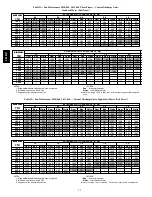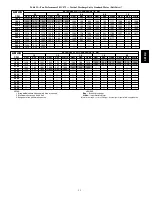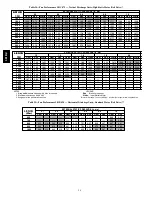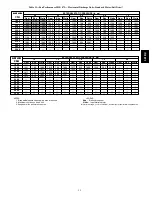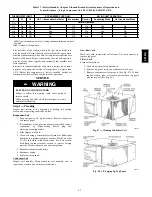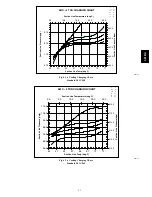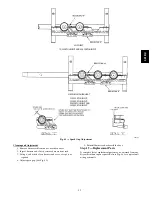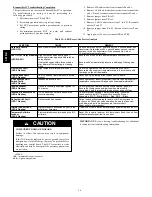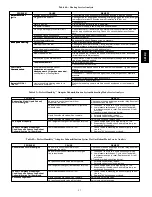
42
Compressor Rotation
On 3-phase units be certain that the compressor is rotating in the
proper direction. To determine whether or not compressor is
rotating in the proper direction:
1. Connect the service gauges to suction and discharge
pressure fittings.
2. Energize the compressor.
3. The suction pressure should drop and the discharge
pressure should rise, as is normal on any start-up.
If the suction pressure does not drop and the discharge pressure
does not rise to normal levels:
1. Note that the indoor fan (006 and 007 three-phase units
only) is probably also rotating in the wrong direction.
2. Turn off power to the unit and tag disconnect.
3. Reverse any two of the unit power leads.
4. Turn on power to the unit and energize the compressor.
The suction and discharge pressure levels should now move to
their normal start-up levels.
NOTE
: When the compressor is rotating in the wrong direction,
the unit makes more noise and does not provide cooling.
Cooling
Set the space thermostat to the OFF position. Set the system
selector switch at COOL position and the fan switch at AUTO
position. Adjust the thermostat to a setting below room
temperature. The compressor starts when contactor closes.
Check the unit charge. Refer to Refrigerant Charge section.
Reset the thermostat at a position above room temperature. The
compressor will shut off. Evaporator fan will shut off after a
30--second delay.
To Shut Off Unit -- Set the system selector switch at OFF
position. Resetting the thermostat at a position above room
temperature shuts off the unit temporarily until the space
temperature exceeds the thermostat setting. Units are equipped
with a Cycle-LOC
™
protection device. The unit shuts down on
any safety trip and remains off; an indicator light on the
thermostat comes on. Check the reason for the safety trip.
Main Burners
Main burners are factory set and should require no adjustment.
TO CHECK ignition of main burners and heating controls, move
thermostat set point above room temperature and verify that the
burners light and evaporator fan is energized. Check heating
effect, then lower the thermostat setting below the room
temperature and verify that the burners and evaporator fan turn
off.
Refer to Tables 35 and 36 for the correct orifice to use at high
altitudes.
Table 35—Altitude Compensation*
581B 036--072, 581C 024--060 Standard Units
72,000 AND
115 000 BTUH
150,000 BTUH
ELEVATION
115,000 BTUH
NOMINAL INPUT
150,000 BTUH
NOMINAL INPUT
ELEVATION
(ft)
Natural
Liquid
Natural
Liquid
(ft)
Natural
Gas
Liquid
Propane
Natural
Gas
Liquid
Propane
Gas
Orifice
Propane
Orifice
Gas
Orifice
Propane
Orifice
Orifice
Size†
Orifice
Size†
Orifice
Size†
Orifice
Size†
0-2,000
33
43
30
37
2,000
36
44
31
39
3,000
36
45
31
40
4,000
37
45
32
41
5,000
38
46
32
42
6,000
40
47
34
43
7,000
41
48
35
43
8,000
42
49
36
44
9,000
43
50
37
45
10,000
44
50
39
46
11,000
45
51
41
47
12,000
46
52
42
48
13,000
47
52
43
49
14,000
48
53
44
50
*As the height above sea level increases, there is less oxygen per cubic
foot of air. Therefore, heat input rate should be reduced at higher alti-
tudes.
†Orifices available through your Bryant distributor.
Table 36—Altitude Compensation* —
581B 036--072, 581C 024--060 Low NOx Units
ELEVATION
60,000 AND
90,000 BTUH
NOMINAL INPUT
120,000 BTUH
NOMINAL INPUT
ELEVATION
(ft)
Natural
Gas
Orifice
Size†
Liquid
Propane
Orifice
Size†
Natural
Gas
Orifice
Size
Liquid
Propane
Orifice
Size†
0-2,000
38
45
32
42
2,000
40
47
33
43
3,000
41
48
35
43
4,000
42
49
36
44
5,000
43
49
37
45
6,000
43
50
38
45
7,000
44
50
39
46
8,000
45
51
41
47
9,000
46
52
42
48
10,000
47
52
43
49
11,000
48
53
44
50
12,000
49
53
44
51
13,000
50
54
46
52
14,000
51
54
47
52
*As the height above sea level increases, there is less oxygen per cubic
foot of air. Therefore, the input rate should be reduced at higher alti-
tudes.
†Orifices are available through your local Bryant distributor.
581B
,C





